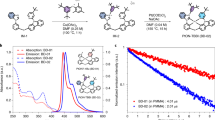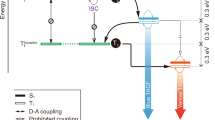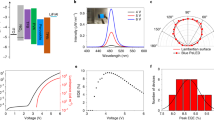Abstract
Phosphorescent organic light-emitting diodes (PHOLEDs) feature high efficiency1,2, brightness and colour tunability suitable for both display and lighting applications3. However, overcoming the short operational lifetime of blue PHOLEDs remains one of the most challenging high-value problems in the field of organic electronics. Their short lifetimes originate from the annihilation of high-energy, long-lived blue triplets that leads to molecular dissociation4,5,6,7. The Purcell effect, the enhancement of the radiative decay rate in a microcavity, can reduce the triplet density and, hence, the probability of destructive high-energy triplet–polaron annihilation (TPA)5,6 and triplet–triplet annihilation (TTA) events4,5,7,8. Here we introduce the polariton-enhanced Purcell effect in blue PHOLEDs. We find that plasmon–exciton polaritons9 (PEPs) substantially increase the strength of the Purcell effect and achieve an average Purcell factor (PF) of 2.4 ± 0.2 over a 50-nm-thick emission layer (EML) in a blue PHOLED. A 5.3-fold improvement in LT90 (the time for the PHOLED luminance to decay to 90% of its initial value) of a cyan-emitting Ir-complex device is achieved compared with its use in a conventional PHOLED. Shifting the chromaticity coordinates to (0.14, 0.14) and (0.15, 0.20) into the deep blue, the Purcell-enhanced devices achieve 10–14 times improvement over similarly deep-blue PHOLEDs, with one structure reaching the longest Ir-complex device lifetime of LT90 = 140 ± 20 h reported so far10,11,12,13,14,15,16,17,18,19,20,21. The polariton-enhanced Purcell effect and microcavity engineering provide new possibilities for extending deep-blue PHOLED lifetimes.
This is a preview of subscription content, access via your institution
Access options
Access Nature and 54 other Nature Portfolio journals
Get Nature+, our best-value online-access subscription
$29.99 / 30 days
cancel any time
Subscribe to this journal
Receive 51 print issues and online access
$199.00 per year
only $3.90 per issue
Buy this article
- Purchase on Springer Link
- Instant access to full article PDF
Prices may be subject to local taxes which are calculated during checkout





Similar content being viewed by others
Data availability
The data that support the findings of this study are available from the corresponding author on request.
References
Baldo, M. A. et al. Highly efficient phosphorescent emission from organic electroluminescent devices. Nature 395, 151–154 (1998).
Adachi, C., Baldo, M. A., Thompson, M. E. & Forrest, S. R. Nearly 100% internal phosphorescence efficiency in an organic light emitting device. J. Appl. Phys. 90, 5048–5051 (2001).
Universal PHOLED Product Data. https://www.oled-info.com/files/UDC-Product-Sheets-sid-2011.pdf (2011).
Forrest, S. R. Organic Electronics: Foundations to Applications (Oxford Univ. Press, 2020).
Giebink, N. C. et al. Intrinsic luminance loss in phosphorescent small-molecule organic light emitting devices due to bimolecular annihilation reactions. J. Appl. Phys. 103, 044509 (2008).
Giebink, N. C., D’Andrade, B. W., Weaver, M. S., Brow, J. J. & Forrest, S. R. Direct evidence for degradation of polaron excited states in organic light emitting diodes. J. Appl. Phys. 105, 124514 (2009).
Jeong, C. et al. Understanding molecular fragmentation in blue phosphorescent organic light-emitting devices. Org. Electron. 64, 15–21 (2019).
Ha, D. G. et al. Dominance of exciton lifetime in the stability of phosphorescent dyes. Adv. Opt. Mater. 7, 1901048 (2019).
Dintinger, J., Klein, S., Bustos, F., Barnes, W. L. & Ebbesen, T. W. Strong coupling between surface plasmon-polaritons and organic molecules in subwavelength hole arrays. Phys. Rev. B 71, 035424 (2005).
Zhang, Y., Lee, J. & Forrest, S. R. Tenfold increase in the lifetime of blue phosphorescent organic light-emitting diodes. Nat. Commun. 5, 5008 (2014).
Lee, J. et al. Hot excited state management for long-lived blue phosphorescent organic light-emitting diodes. Nat. Commun. 8, 15566 (2017).
Kim, S. et al. Degradation of blue-phosphorescent organic light-emitting devices involves exciton-induced generation of polaron pair within emitting layers. Nat. Commun. 9, 1211 (2018).
Bae, H. J. Protecting benzylic C–H bonds by deuteration doubles the operational lifetime of deep-blue Ir-phenylimidazole dopants in phosphorescent OLEDs. Adv. Opt. Mater. 9, 2100630 (2021).
Sim, B. et al. Comprehensive model of the degradation of organic light-emitting diodes and application for efficient, stable blue phosphorescent devices with reduced influence of polarons. Phys. Rev. Appl. 14, 024002 (2020).
Yang, K. et al. Effects of charge dynamics in the emission layer on the operational lifetimes of blue phosphorescent organic light-emitting diodes. Adv. Funct. Mater. 32, 2108595 (2022).
Zhao, H. et al. Control of host-matrix morphology enables efficient deep-blue organic light-emitting devices. Adv. Mater. 35, 2210794 (2023).
Ihn, S. G. et al. Cohosts with efficient host-to-emitter energy transfer for stable blue phosphorescent organic light-emitting diodes. J. Mater. Chem. C 9, 17412–17418 (2021).
Choi, K. H., Lee, K. H., Lee, J. Y. & Kim, T. Simultaneous achievement of high efficiency and long lifetime in deep blue phosphorescent organic light-emitting diodes. Adv. Opt. Mater. 7, 1901374 (2019).
Shin, S. K., Han, S. H. & Lee, J. Y. High triplet energy exciplex host derived from a CN modified carbazole based n-type host for improved efficiency and lifetime in blue phosphorescent organic light-emitting diodes. J. Mater. Chem. C 6, 10308–10314 (2018).
Kim, J. S. et al. Improved efficiency and stability of blue phosphorescent organic light emitting diodes by enhanced orientation of homoleptic cyclometalated Ir(III) complexes. Adv. Opt. Mater. 8, 2001103 (2020).
Jung, M., Lee, K. H., Lee, J. Y. & Kim, T. A bipolar host based high triplet energy electroplex for an over 10000 h lifetime in pure blue phosphorescent organic light-emitting diodes. Mater. Horiz. 7, 559–565 (2020).
Sun, J. et al. Exceptionally stable blue phosphorescent organic light-emitting diodes. Nat. Photonics 16, 212–218 (2022).
Bulović, V., Khalfin, V., Gu, G., Burrows, P. & Garbuzov, D. Weak microcavity effects in organic light-emitting devices. Phys. Rev. B 58, 3730–3740 (1998).
Fusella, M. A. et al. Plasmonic enhancement of stability and brightness in organic light-emitting devices. Nature 585, 379–382 (2020).
Zengin, G. et al. Realizing strong light-matter interactions between single-nanoparticle plasmons and molecular excitons at ambient conditions. Phys. Rev. Lett. 114, 157401 (2015).
Deng, H., Haug, H. & Yamamoto, Y. Exciton-polariton Bose-Einstein condensation. Rev. Mod. Phys. 82, 1489–1537 (2010).
Novotny, L. & Hecht, B. Principles of Nano-Optics (Cambridge Univ. Press, 2012).
Togashi, K., Nomura, S., Yokoyama, N., Yasuda, T. & Adachi, C. Low driving voltage characteristics of triphenylene derivatives as electron transport materials in organic light-emitting diodes. J. Mater. Chem. 22, 20689–20695 (2012).
Yang, H. U. et al. Optical dielectric function of silver. Phys. Rev. B 91, 235137 (2015).
Kim, S. Y. et al. Organic light-emitting diodes with 30% external quantum efficiency based on a horizontally oriented emitter. Adv. Funct. Mater. 23, 3896–3900 (2013).
Celebi, K., Heidel, T. D. & Baldo, M. A. Simplified calculation of dipole energy transport in a multilayer stack using dyadic Green’s functions. Opt. Express 15, 1762 (2007).
Chance, R. R., Prock, A. & Silbey, R. Molecular fluorescence and energy transfer near interfaces. Adv. Chem. Phys. 37, 1–65 (2007).
Hou, S., Qu, Y., Liu, X. & Forrest, S. R. Ultrastrong coupling of vibrationally dressed organic Frenkel excitons with Bloch surface waves in a one-sided all-dielectric structure. Phys. Rev. B 100, 045410 (2019).
Forrest, S. R., Bradley, D. D. C. & Thompson, M. E. Measuring the efficiency of organic light-emitting devices. Adv. Mater. 15, 1043–1048 (2003).
Acknowledgements
We thank J.-Y. Lee from Sungkyunkwan University for providing SiTrzCz2 and Ir(cb)3 and J. Kim from Yonsei University for helpful discussions. This material is based on work partially supported by the U.S. Department of Energy’s Office of Energy Efficiency and Renewable Energy (EERE) under award number DE-EE0009688. This report was prepared as an account of work sponsored by an agency of the United States Government. Neither the United States Government nor any agency thereof, nor any of their employees, makes any warranty, expressed or implied, or assumes any legal liability or responsibility for the accuracy, completeness or usefulness of any information, apparatus, product or process disclosed, or represents that its use would not infringe privately owned rights. Reference herein to any specific commercial product, process or service by trade name, trademark, manufacturer or otherwise does not necessarily constitute or imply its endorsement, recommendation or favouring by the United States Government or any agency thereof. The views and opinions of the authors expressed herein do not necessarily state or reflect those of the United States Government or any agency thereof. We also thank Universal Display Corp. for partial financial support of this research.
Author information
Authors and Affiliations
Contributions
H.Z. planned the experiments, built the experimental setup and conducted the experiments and simulations. D.F. helped with fabrication. C.E.A. helped with obtaining the optical data. S.R.F. planned and supervised the project and analysed the data. All authors contributed to the preparation of the manuscript and analysed the data.
Corresponding author
Ethics declarations
Competing interests
S.R.F. has an equity interest in Universal Display Corp. This apparent conflict is under management by the University of Michigan Office of Research. Also, the University of Michigan has a royalty-bearing license agreement with Universal Display Corp.
Peer review
Peer review information
Nature thanks the anonymous reviewers for their contribution to the peer review of this work.
Additional information
Publisher’s note Springer Nature remains neutral with regard to jurisdictional claims in published maps and institutional affiliations.
Extended data figures and tables
Extended Data Fig. 1 Molecular structural formulae of organic materials used in the EML, ETL and hosts.
The molecules are all deposited from vacuum along with other molecules forming the complete OLED structures, whose complete chemical nomenclatures are provided in Methods.
Extended Data Fig. 2 Angle-resolved TM-mode reflectance of Al/BPyTP2.
The measurement angles are increased from θ = 51° to 87° by 3° increments, indicated by solid lines. The dashed black lines provide guides to the dispersion of LP, MP and UP branches. The extinction coefficient of BPyTP2 is shown by the filled pink area. The PEP dispersion in Fig. 2a is fitted to the local minima. Inset, ellipsometry measurement setup. 20-nm-thick Al/20 nm BPyTP2 is coated on a prism coupler.
Extended Data Fig. 3 Device structures used in this study.
C, H and F label the cathode and anode structures and 1–6 label the organic structures sandwiched between the electrodes.
Extended Data Fig. 4 Simulated and measured PFs for the devices studied.
a, ODoS distribution simulated using dyadic Green’s functions31,32 for structure C with a 15-nm-thick SF3Trz ETL and structure F with a 15-nm-thick BPyTP2 ETL. The triplet dipole position is in the middle of the EML with an isotropic orientation relative to the film plane. Dashed white lines separate regions of different optical modes. Structure F has a low-Q Ag/DBR cavity mode at kx/k0 < 1. The relative ODoS intensity is labelled by the colour bar on the right. The ODoS for structure C is multiplied by five for comparison. b, Simulated PF versus triplet emitter position for structures C and F for different cathode/ETL combinations. The horizontal and vertical dipoles are labelled by dash blue and red lines, respectively. The PF for isotropic dipoles is averaged over 67% horizontal (in-plane) and 33% vertical (orange line) dipoles. The measured PF of horizontal dipoles is labelled by diamonds at 45 nm from the cathode, corresponding to the centre of the 50-nm-thick EML. The simulated centre wavelength is 465 nm. c, Simulated PF of isotropic dipoles in half cavities H versus wavelength overlapped with the Ir(dmp)3 PL spectrum. The exciton is located at 36 nm from the interfaces of Ag/BPyTP2, Al/BPyTP2, Ag/SF3Trz and Al/SF3Trz. d, Measured normalized decay rate, kr/kr,0 overlaid with the simulated PFs for horizontal (PFhor) and isotropic (PFiso) dipoles using the Green’s function method31,32. Here kr,0 is the decay rate of the bare EML.
Extended Data Fig. 5 Ir(dmp)3 device energy levels and performance.
a, Device structure and frontier orbital levels (in eV). b, EQE versus J of C1–C3, H1–H3 and F1–F3. EQE data are averaged from at least from two different batches with two devices in each batch. c, EL spectra of C1– C3, H1–H3 and F1–F3 at J = 10 mA cm−2. Inset, chromaticity coordinates of the devices. The arrow indicates the blueshift from the control to the full-cavity devices. d, Current–voltage (J–V, left axis) and luminance (right axis) characteristics of C1–C3, H1–H3 and F1–F3. e, Device operational lifetime for C1–C3, H1–H3 and F1–F3 at J = 7 mA cm−2. For C1–C3, H1–H3 and F1, lifetime data are shown from two devices in different batches. For F2 and F3, lifetime data are shown from three devices in different batches. Shaded area indicates the 95% confidence interval. Solid black lines are fits to a stretched exponential: L(t)/L0 = exp[−(t/t0)β] for C and F devices, in which L0 is the initial luminance and t0 and β are parameters (see Extended Data Table 2).
Extended Data Fig. 6 Ir(cb)3 device energy levels and performance.
a, Device structure and frontier orbital levels (in eV). b, Device operational lifetime at J = 5 mA cm−2. Errors are indicated in Extended Data Table 1. Average from three devices for each curve. Solid black lines are fits to a stretched exponential: L(t)/L0 = exp[−(t/t0)β], in which L0 is the initial luminance and t0 and β are parameters (see Extended Data Table 2). c, EL spectra of C4–C6 and H5 and H6 at J = 10 mA cm−2. d, EQE versus J of C4, C5 and C6 and H5 and H6. Errors are indicated in Extended Data Table 1. Average from three devices for each curve. e, J–V (left axis) and luminance (right axis) characteristics of C4–C6 and H5 and H6.
Rights and permissions
Springer Nature or its licensor (e.g. a society or other partner) holds exclusive rights to this article under a publishing agreement with the author(s) or other rightsholder(s); author self-archiving of the accepted manuscript version of this article is solely governed by the terms of such publishing agreement and applicable law.
About this article
Cite this article
Zhao, H., Arneson, C.E., Fan, D. et al. Stable blue phosphorescent organic LEDs that use polariton-enhanced Purcell effects. Nature 626, 300–305 (2024). https://doi.org/10.1038/s41586-023-06976-8
Received:
Accepted:
Published:
Issue Date:
DOI: https://doi.org/10.1038/s41586-023-06976-8
Comments
By submitting a comment you agree to abide by our Terms and Community Guidelines. If you find something abusive or that does not comply with our terms or guidelines please flag it as inappropriate.



